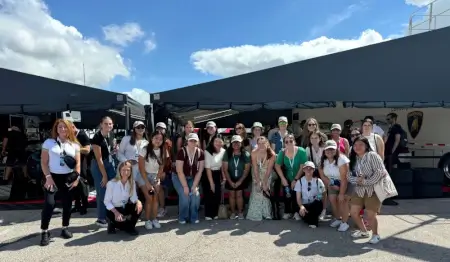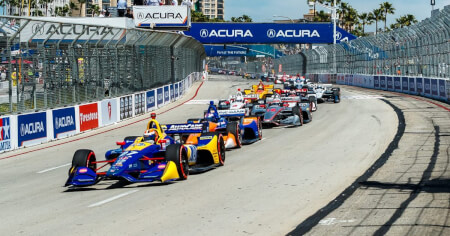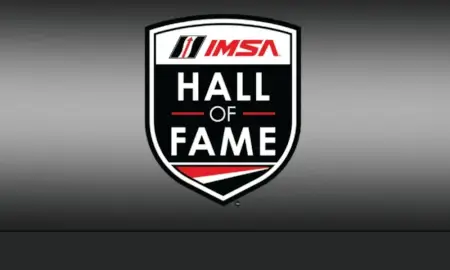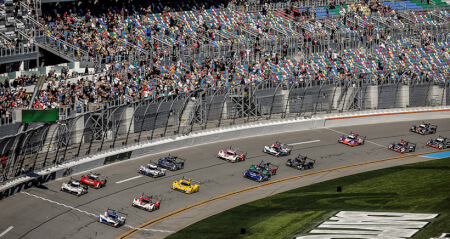October 10th 2022
2024 Corvette Z06 GT3.R undergoes initial testing
The Chevrolet Corvette Z06 GT3.R scheduled to make its debut at the 2024 Rolex 24 at Daytona has taken its first steps into the world, with a shakedown at GM’s Milford Proving Grounds and a first test at Mid-Ohio completed recently.
“We just completed our first shakedown last week. We were thrilled to use our own facility over in Milford, Michigan to do that,” says Christie Bagne, the assistant sports car racing program manager at GM who has largely overseen GT racing projects in recent years. “We announced this at Petit last year, effectively, and then we had a year of really cranking on designing and developing this car, and beginning to put together what the customer support structure will look like. So it’s really exciting that with all that hard work, we’re finally getting to see our car go around on track. It went really well; we’ve met our goals in terms of early reliability and systems checks, so it’s been a really successful start for the car.”
Current Corvette Racing drivers Jordan Taylor, Antonio Garcia and Tommy Milner all had the opportunity to drive the C8 developed with Pratt Miller in the test. “Tommy got out of the car and said, “It already feels like a race car.” We wanted to be at that point after that Mid-Ohio test, where we were truly focused on tuning the balance of the car and the performance of the car. And that’s where we are, so the team is happy. We’ve accomplished our goals there and the driver feedback has been very positive so far,” Bagne added.
With the first test done, the focus turns to performance development and creating a customer support infrastructure, something that wasn’t a consideration in Corvette’s factory racing program. But the focus on customer racing goes beyond having a parts truck and engineering support — it means building a car that’s a good fit for gentleman drivers.
“You’ll see it in everything we do, developing this program. We want the car to be friendly for an amateur driver. With the C8 mid-engine platform and the center of gravity of the car, it makes it a really great and predictable car to drive, which is awesome. It’s come up in the conversations and making sure the car is easy for customer teams to work on. It’s come up in terms of…using this really great 5.5-liter LT6 engine architecture — and we have that in the GTE car — and we’ve tried to bring in even more production content for the GT3 race car, which enables a lower cost for our customers and then also a longer service life for our customers. So everything we’re doing as we develop this program is really heavily customer-focused, which is a different mindset from the factory racing that we’ve done in the past,” Bagne explained.
Some of the things that the Pratt Miller team is working on to keep it customer-friendly include making ingress and egress easier while maintaining the side impact protections that Corvette has developed. Beyond that, Bagne can’t share much about the car before homologation — expected next fall – except that, like all GT3 cars, it’s much closer to the production Z06 than the GTE/GTLM car and that the car uses the 5.5-liter LT6 V8.
Bagne could say, however, that many of the lessons learned as Corvette Racing adapted its GTE car to compete in the IMSA WeatherTech SportsCar Championship GTD class will go into the GT3.R, such as ABS tuning and using the customer tire vs. the confidential tire it could use in GTE. Much was learned as the team had to integrate the driver aid systems into the car as it was adapted and some of that work was then translated into simulation. Bagne said the initial testing has shown a good correlation between the simulation work and the way things are working on the GT3.R prototype.
GM is targeting the first customer car deliveries next fall, with IMSA WeatherTech Championship teams the priority. Bagne said the hope is that there will be both GTD PRO and GTD Corvette teams on the grid at the 2024 Rolex 24 at Daytona, and a customer team at the 24 Hours of Le Mans that June. Beyond that, they’ll look at populating other GT3 series in North America and worldwide, such as GT World Challenge.
Interest in the car is high, she said, and they’re talking to potential customer teams to understand their priorities so that they may build a strong customer program from the beginning — something GM didn’t achieve with the Camaro GT4.R.
“One of the exercises that I went through since I was working closely with our GT4 Camaro teams was understanding what could have been better, so I went to them and I said, ‘What was good about the support we provided [and] what was not?’ We got feedback that not having a parts truck on site was something that was really a downside of running the Camaro GT4. We took that and thought, ‘OK, we’ve got to kick off our parts truck right away for the GT3; we need to have that kind of support.’ We got some positive feedback, too, on the engineering support that we were able to provide on those programs — things like making sure the car is easy for our customer teams to work on, easy for them to run. That’s something that we’ve really focused on and taken away from that and just the mindset of supporting our customers.”
GM and Pratt Miller plan a number of further tests at familiar tracks over the next few months to further refine the performance and get the car ready for homologation.
“We just completed our first shakedown last week. We were thrilled to use our own facility over in Milford, Michigan to do that,” says Christie Bagne, the assistant sports car racing program manager at GM who has largely overseen GT racing projects in recent years. “We announced this at Petit last year, effectively, and then we had a year of really cranking on designing and developing this car, and beginning to put together what the customer support structure will look like. So it’s really exciting that with all that hard work, we’re finally getting to see our car go around on track. It went really well; we’ve met our goals in terms of early reliability and systems checks, so it’s been a really successful start for the car.”
Current Corvette Racing drivers Jordan Taylor, Antonio Garcia and Tommy Milner all had the opportunity to drive the C8 developed with Pratt Miller in the test. “Tommy got out of the car and said, “It already feels like a race car.” We wanted to be at that point after that Mid-Ohio test, where we were truly focused on tuning the balance of the car and the performance of the car. And that’s where we are, so the team is happy. We’ve accomplished our goals there and the driver feedback has been very positive so far,” Bagne added.
With the first test done, the focus turns to performance development and creating a customer support infrastructure, something that wasn’t a consideration in Corvette’s factory racing program. But the focus on customer racing goes beyond having a parts truck and engineering support — it means building a car that’s a good fit for gentleman drivers.
“You’ll see it in everything we do, developing this program. We want the car to be friendly for an amateur driver. With the C8 mid-engine platform and the center of gravity of the car, it makes it a really great and predictable car to drive, which is awesome. It’s come up in the conversations and making sure the car is easy for customer teams to work on. It’s come up in terms of…using this really great 5.5-liter LT6 engine architecture — and we have that in the GTE car — and we’ve tried to bring in even more production content for the GT3 race car, which enables a lower cost for our customers and then also a longer service life for our customers. So everything we’re doing as we develop this program is really heavily customer-focused, which is a different mindset from the factory racing that we’ve done in the past,” Bagne explained.
Some of the things that the Pratt Miller team is working on to keep it customer-friendly include making ingress and egress easier while maintaining the side impact protections that Corvette has developed. Beyond that, Bagne can’t share much about the car before homologation — expected next fall – except that, like all GT3 cars, it’s much closer to the production Z06 than the GTE/GTLM car and that the car uses the 5.5-liter LT6 V8.
Bagne could say, however, that many of the lessons learned as Corvette Racing adapted its GTE car to compete in the IMSA WeatherTech SportsCar Championship GTD class will go into the GT3.R, such as ABS tuning and using the customer tire vs. the confidential tire it could use in GTE. Much was learned as the team had to integrate the driver aid systems into the car as it was adapted and some of that work was then translated into simulation. Bagne said the initial testing has shown a good correlation between the simulation work and the way things are working on the GT3.R prototype.
GM is targeting the first customer car deliveries next fall, with IMSA WeatherTech Championship teams the priority. Bagne said the hope is that there will be both GTD PRO and GTD Corvette teams on the grid at the 2024 Rolex 24 at Daytona, and a customer team at the 24 Hours of Le Mans that June. Beyond that, they’ll look at populating other GT3 series in North America and worldwide, such as GT World Challenge.
Interest in the car is high, she said, and they’re talking to potential customer teams to understand their priorities so that they may build a strong customer program from the beginning — something GM didn’t achieve with the Camaro GT4.R.
“One of the exercises that I went through since I was working closely with our GT4 Camaro teams was understanding what could have been better, so I went to them and I said, ‘What was good about the support we provided [and] what was not?’ We got feedback that not having a parts truck on site was something that was really a downside of running the Camaro GT4. We took that and thought, ‘OK, we’ve got to kick off our parts truck right away for the GT3; we need to have that kind of support.’ We got some positive feedback, too, on the engineering support that we were able to provide on those programs — things like making sure the car is easy for our customer teams to work on, easy for them to run. That’s something that we’ve really focused on and taken away from that and just the mindset of supporting our customers.”
GM and Pratt Miller plan a number of further tests at familiar tracks over the next few months to further refine the performance and get the car ready for homologation.














